 |
This command is only available with the Generative
Shape Design 2 product and providing you have KT1 or PKT licenses. |

|
This task shows how to instantiate Power Copies using
step by step instantiation once they have been created as described in
Creating Power Copies (see related chapter). |
 |
This instantiation mode is only available providing the Power Copy to
be created is ordered and the chosen destination (that is the current
feature) respects ordering rules. |
 |
Open the
PowerCopyDestination2.CATPart document. |

|
-
Click Instantiate From Document
 or select Insert > Instantiate From Document from the menu
bar.
or select Insert > Instantiate From Document from the menu
bar.
| The File Selection dialog box is displayed allowing you to
navigate to the document where the PowerCopy is stored. |
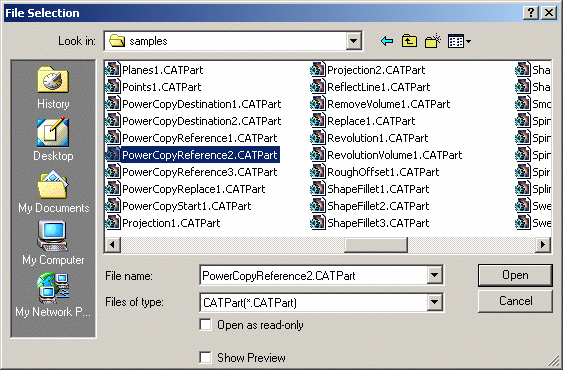 |
-
Select the document containing the Powercopy, and click
Open.
| Here we selected the
PowerCopyReference2.CATPart document. |
| The Insert Object dialog box is displayed. Warning or error messages can be issued if the chosen
destination is ambiguous or forbidden, for instance if you select an
ordered geometrical set as the After destination.
-
In case
of an error message, the destination field is emptied and the
OK button is unavailable.
-
In
case of a warning message, the power copy can still be instantiated
but some elements may not be inserted in the chosen destination.
|
| Use the Reference list to
choose the correct Power Copy when several have been defined in the
document. |
-
Select the Step by step instantiation
mode.
| The
Inputs
field is grayed out. |
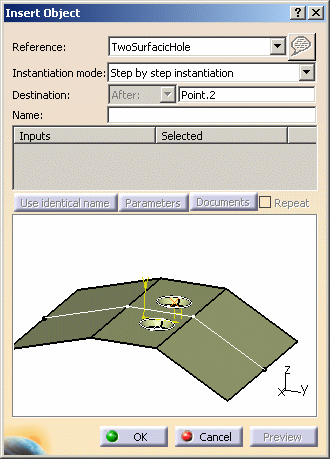 |
-
Select the Destination
of the instantiation.
|
It is
composed of two elements: a combo list corresponding to the relative
position (Inside or After) and a field
containing the destination feature. |
|
The destination depends on the current feature
as it is automatically filled with the latter. If
there is no current feature, the field is empty. |
-
When
possible, you can modify the default destination, either by
modifying the relative position or by selecting another destination
feature.
-
The
destination is filled with After when the destination is
a geometric feature. In this case, the After field is
grayed out.
-
The
destination is filled with Inside when the destination
is a geometrical feature set.
|
-
Click OK.
| A PowerCopy Instances node is automatically created in the
specification tree of the current document. The Comparison Window
opens on the right side of the screen and the Scan and
Synchronization toolbars are launched. |
 |
| |
 |
The Power Copy instance feature stores several information:
- A link to the referenced Power Copy. This link will be later
used to retrieve the referenced CATPart and the inputs' geometry.
- The list of inputs to valuate in the current CATPart as well as
their role.
- The list of parameters published by the Power Copy during its
creation.
- The mapping between referenced objects and instantiated
objects.
|
| You cannot delete the Power Copy instance feature as long as
instantiated features inputs are not valuated. An error message is
displayed if you do so. Deletion is possible only when instantiated
features have all their inputs valuated, i.e. when the instantiation
is completed, or when all instantiated features are deleted. |
|
|
When editing a
feature in the Comparison Window, the edited feature is highlighted
simultaneously on both left and right sides of the screen, in
specification trees and 3D areas. |
 |
-
Click First
 or First to update
or First to update
 in the Scan toolbar to update the features instantiated by the PowerCopy.
in the Scan toolbar to update the features instantiated by the PowerCopy.
 |
Only the Structure mode is
available here. |
| Each time the scan finds a feature that needs inputs, a dialog
box is launched to valuate them. Only the necessary inputs are
requested. |
| Here Circle.1 is the first instantiated feature that need inputs. |
 |
Note that:
- The visualization is automatically synchronized on Circle.1 (in
the right viewer). It lets you visualized the reference model with
the exact display during the circle creation.
- Indicators are displayed in the right viewer to identify the
previous inputs and each input is highlighted.
- After the inputs are selected, the scan command is still
active.
- You must select inputs in the order they appear in the dialog
box.
|
-
Select the value for each input.
| After each selection, an indicator is displayed in the left
viewer, with orientation when necessary. Click on the green arrow to
reverse orientation if needed. |
 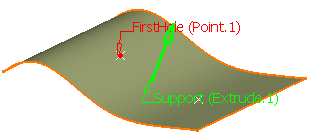 |
| |
- Click
OK.
| Circle.1 is updated. |
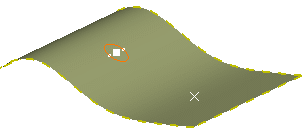 |
- Click
Next
 or
Play update
or
Play update
 to continue the inputs valuation.
to continue the inputs valuation.
- Once the update
is finished, you can close the Scan command as well as the Comparison
Window.
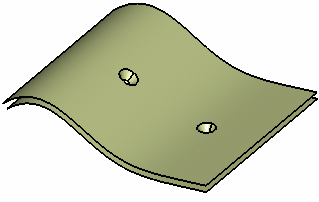 |
 |
- The Scan command can be interrupted at any step if you need to
create or modify a feature to valuate an input. You can do so while
the Comparison window is still active: simply re-launch the Scan
command once the creation or modification is done.
- The Power Copy instance feature that contains all the
information is persistent. Therefore you can save the CATPart
before (or during) the Scan update, close your session, launch a
new session and launch the Scan command again to valuate the
inputs. Step by step instantiation is completed when all inputs are
correctly selected.
- If you skip some steps (by direct selection in the tree during
the Scan command or by using Last button for
instance), you will still need to valuate the inputs of all
intermediate steps and a warning message is issued.
| Indeed the Scan command stops as soon as a feature needs
inputs valuation and this feature is then defined as the in
work object, in order to prevent the selection of inputs which
are below it. |
|
| |
- If the reference CATPart is not found, the scan and the input
valuation can be performed but the Comparison Window is not
available and the old inputs (with reference orientation) cannot be
displayed.
|
|
|
|
| |
Nested Power Copies
|
 |
This instantiation mode is only available providing the Power Copy to
be created is ordered and the chosen destination (that is the current
feature) respects ordering rules. |
|
It lets you perform several Power Copies instantiation at
the same time. |
 |
Perform steps 1 to 5 of the Step by step
instantiation. |
| |
In this scenario, we are not going to select the point as
input for Circle.1: indeed the center of the circle is to be created using
another Power Copy. |
| |
-
Click Cancel
in the Definition dialog box.
-
Click Instantiate From Document
 (or select Insert > Instantiate From Document... from the menu
bar) and navigate to the
PowerCopyReference3.CATPart document in the File Selection dialog
box.
(or select Insert > Instantiate From Document... from the menu
bar) and navigate to the
PowerCopyReference3.CATPart document in the File Selection dialog
box.
-
Select the Step by step instantiation mode.
-
Click OK.
| A new Comparison Window is created with the destination CATPart
on the left and the TwoPointOnASurface PowerCopy reference on the
right. You can either work from this window or switch to the initial
window containing the destination CATPart. |
| The new instantiated features are inserted after the current one:
here after Point.2. |
| The scan command is launched. |
 |
| A new Power Copy instance is added under the PowerCopy Instances
node: |
 |
-
Click First
 or First to update
or First to update
 in the Scan toolbar to update the features instantiated by the Power
Copy.
in the Scan toolbar to update the features instantiated by the Power
Copy.
 |
Only the Structure mode is
available here. |
| Each time the scan finds a feature that needs inputs, a dialog
box is launched to valuate the inputs. Here Point.3 is the first
instantiated feature that need inputs. |
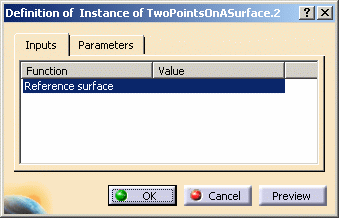 |
-
Select the value for the Reference surface.
| After each selection, an indicator is displayed in the left
viewer, with orientation when necessary. Click on the green arrow to
reverse orientation if needed. |
 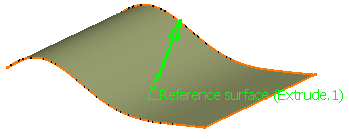 |
- Click
OK.
| Point.3 is updated. |
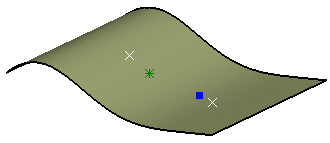 |
| The instantiation of TwoPointsOnASurface Power Copy is now
completed. All instantiated features are updated and you may delete
the Power Copy instance feature if desired and the corresponding
Comparison Window can be closed. |
- Click
Next
 or
Play update
or
Play update
 . .
| The next feature that needs inputs is Circle.1. |
 |
- As this feature belongs to the first instantiated Power Copy,
the Comparison Window automatically changes to display the CATPart
containing the right Power Copy reference.
- Even if the previous Comparison Window (corresponding to the
TwoPointsOnASurface Power Copy instance) has not been closed, the
Comparison Window corresponding to the right Power Copy instance (TwoSurfacicHoles)
appears in the right viewer.
- Indicators are displayed in the right viewer to identify the
previous inputs and each input is highlighted.
|
- Select the value
for each input.
| The first input can now be valuated with one of the two
previously created features. |
| After each selection, an indicator is displayed in the left
viewer, with orientation when necessary. Click on the green arrow to
reverse orientation if needed. |
 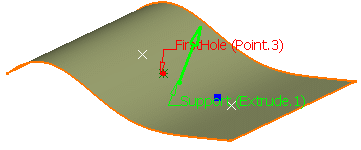 |
- Click
OK.
| Circle.1 is updated. |
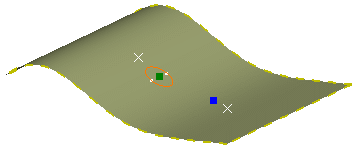 |
- Click
Next
 or
Play update
or
Play update
 . .
| An input is requested for Circle.2. |
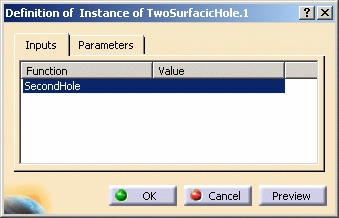 |
- Select the other
created point and click OK.
 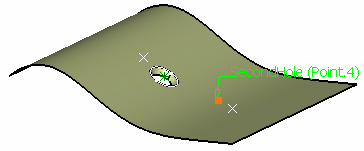 |
| Circle.2 is now updated and all inputs of TwoSurfacicHoles are
valuated. |
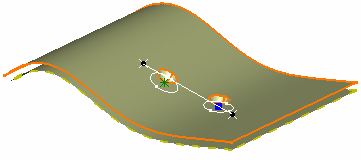 |
- Close the
Comparison Window.
 |
 |
- Now if you launch the
Quick Select command
 ,
either in the left or in the right window, the visualization is
updated in both windows: pre-highlighting is synchronous and a
color code indicates the current selection (green labels) in the
Quick Select dialog box and the parents/children (red labels). ,
either in the left or in the right window, the visualization is
updated in both windows: pre-highlighting is synchronous and a
color code indicates the current selection (green labels) in the
Quick Select dialog box and the parents/children (red labels).
- Once all Power Copies have been
instantiated, you can close the comparison windows that are still
open and delete the Power Copy instance features.
|
|
|
|
|

|
![]()